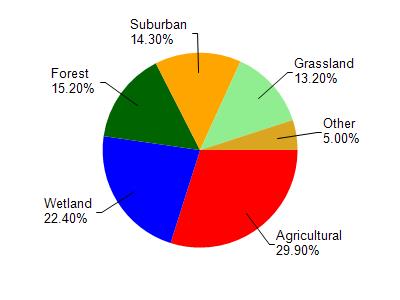Waukesha
No
No
No
Fish and Aquatic Life
Overview
Henrietta Lake, in the Bark River Watershed, is a 22.99 acre lake that falls in Waukesha County. This lake is managed for fishing and swimming and is currently not considered impaired.
Date 2011
Author Aquatic Biologist
Historical Description
Source: 1963, Surface Water Resources of Waukesha County Henrietta Lake T7N, R17E, Section 35 Surface Acres = 23, S.D.F. = 1.19, Maximum Depth = 6 feet.
A small landlocked lake in outwash deposits adjoining the Scuppernong Creek Valley. Shallow marsh borders the south end. Shallowness indicates probable annual winterkill with bullheads comprising a limited fishery. Public access is not available. The lake has some importance for fur bearer and waterfowl production.
Date 1963
Author Surface Water Inventory Of Wisconsin
Condition
Wisconsin has over 84,000 miles of streams, 15,000 lakes and milllions of acres of wetlands. Assessing the condition of this vast amount of water is challenging. The state's water monitoring program uses a media-based, cross-program approach to analyze water condition. An updated monitoring strategy (2015-2020) is now available. Compliance with Clean Water Act fishable, swimmable standards are located in the Executive Summary of Water Condition in 2018. See also the 'monitoring and projects' tab.
Reports
Recommendations
Land Acquisition
The Waukesha Land Conservancy wishes to purchase 60 acres of land in the SW corner of Waukesha County. Two lakes (Henrietta and Waterville) lie within 750 feet of the property and the parcel contains a 3.2 acre lake, named Lily Lake. The property is also adjacent to Scuppernong Creek. The parcel contains deep marsh, a bog and sedge meadow and is listed as Class 1 Wildlife Habitat. The Waukesha Land Conservancy will provide an area for canoe access and parking.
Management Goals
Wisconsin's Water Quality Standards provide qualitative and quantitative goals for waters that are protective of Fishable, Swimmable conditions [Learn more]. Waters that do not meet water quality standards are considered impaired and restoration actions are planned and carried out until the water is once again fishable and swimmable
Management goals can include creation or implementation of a Total Maximum Daily Load analysis, a Nine Key Element Plan, or other restoration work, education and outreach and more. If specific recommendations exist for this water, they will be displayed below online.
Monitoring
Monitoring the condition of a river, stream, or lake includes gathering physical, chemical, biological, and habitat data. Comprehensive studies often gather all these parameters in great detail, while lighter assessment events will involve sampling physical, chemical and biological data such as macroinvertebrates. Aquatic macroinvertebrates and fish communities integrate watershed or catchment condition, providing great insight into overall ecosystem health. Chemical and habitat parameters tell researchers more about human induced problems including contaminated runoff, point source dischargers, or habitat issues that foster or limit the potential of aquatic communities to thrive in a given area. Wisconsin's Water Monitoring Strategy was recenty updated.
Grants and Management Projects
Monitoring Projects
| WBIC | Official Waterbody Name | Station ID | Station Name | Earliest Fieldwork Date | Latest Fieldwork Date | View Station | View Data |
|---|
| 776600 | Henrietta Lake | 10019731 | Henrietta Lake -- Canoe Access | | | Map | Data |
| 776600 | Henrietta Lake | 10007208 | Henrietta Lake | 8/1/1994 | 9/22/2017 | Map | Data |
| 776600 | Henrietta Lake | 683378 | Henrietta Lake - Deep Hole | 10/17/1996 | 3/25/2025 | Map | Data |
|

Watershed Characteristics
Henrietta Lake is located in the Bark River watershed which is 185.84 mi². Land use in the watershed is primarily agricultural (29.90%), wetland (22.40%) and a mix of forest (15.20%) and other uses (32.50%). This watershed has 265.69 stream miles, 3,499.26 lake acres and 22,145.94 wetland acres.
Nonpoint Source Characteristics
This watershed is ranked Medium for runoff impacts on streams, High for runoff impacts on lakes and High for runoff impacts on groundwater and therefore has an overall rank of High. This value can be used in ranking the watershed or individual waterbodies for grant funding under state and county programs.However, all waters are affected by diffuse pollutant sources regardless of initial water quality. Applications for specific runoff projects under state or county grant programs may be pursued. For more information, go to surface water program grants.